فهرست مطالب

نشریه پژوهش های قرآنی
سال هفدهم شماره 3 (پیاپی 67، پاییز 1390)
- تاریخ انتشار: 1390/08/17
- تعداد عناوین: 8
-
صفحه 4این نوشتار در پی تبیین رابطه متقابل ایمان و فضایل اخلاقی است. نویسنده کوشیده است به سه پرسش در این زمینه پاسخ دهد: آیا فضایل اخلاقی در ایجاد ایمان به خدا نقش دارد یا خیر؟ آیا ایمان در پیدایش و ایجاد فضایل اخلاقی نقش دارد یا نه؟ و آیا ایمان در ایجاد حسن و ارزش در فعل اخلاقی موثر است یا خیر؟ نویسنده در هر سه زمینه به دیدگاه ها و ادله هر یک پرداخته و مورد ارزیابی قرار داده است و در نهایت به این نتیجه رسیده است که در سوال نخست، فضایل اخلاقی در پیدایش ایمان از لحاظ نظری نقش دارد، اما از نظر عملی و عینیت خارجی نقشی ندارد؛ مگر بر اساس مطلق توفیق الهی. در سوال دوم ایمان قطعا در پیدایش فضایل اخلاقی نقش دارد، اما با مکانیسم خاصی که در مقاله توضیح داده شده است. و در رابطه با سوال سوم نظر نویسنده این است که ایمان در ایجاد صفت حسن و ارزش عمل نقش ندارد.
کلیدواژگان: ایمان، فضایل اخلاقی -
صفحه 26مناسبات دین و اخلاق از محورهای مهم در «دانش اخلاق» است. اینکه اخلاق چه جایگاه و کاربردهایی در دین و دینداری دارد، و نیز اینکه «دین» چه ره آوردی را برای اخلاق داشته و دارد، از پرسش های اساسی مطرح در این دانش است.
پرسش اخیر در محدوده تاثیرگذاری های قرآن در حیطه دانش و رفتار اخلاقی، در این جستار پیگیری شده است و این موضوع، از منظر کلان در موضوعات گوناگون مطرح و ارائه شده است. این نگرش کلی، ترسیم گر این مدعاست که قرآن کریم، اخلاق و رفتار خاص اخلاقی را توصیه، هدایت و انگیزش سازی می کند.
کلیدواژگان: اخلاق، قرآن، دین، نظام اخلاقی، رفتار اخلاقی -
صفحه 44این مقاله به قابلیت جایگزینی اخلاق به جای ایمان در مساله رستگاری پرداخته است. نویسنده در این زمینه چهار دیدگاه را مورد تحلیل و بررسی قرار داده است: 1- جایگزینی مطلق 2- عدم جایگزینی مطلق 3- جایگزینی در برخی مراتب رستگاری 4- جایگزینی نسبت به برخی انسان ها. نویسنده پس از نقد و ارزیابی ادله هر یک از نظریات، به این نتیجه رسیده است که دو دیدگاه اخیر پذیرفتنی تر از دیدگاه های اول و دوم است و برای تایید آن، شواهدی را آورده است.
کلیدواژگان: ایمان، فضایل اخلاقی، جایگزینی، رستگاری، کافران -
صفحه 70ریپین در این مقاله، نظام جناس سازی را در قرآن بررسی می کند. او ابتدا کلیاتی درباره جناس سازی مطرح می کند. او بر این باور است که جناس ها، پل میان قافیه و استعاره محسوب می شود و جناس از ترکیب صوت با معنا حاصل می آید. سپس ریپین این دو پرسش را مطرح می کند که آیا جناس ها در برساختن گفتمان قرآنی کارآمد عمل می کنند؟ و جناس ها چه کاری را برای خواننده انجام می دهند؟ آن گاه تلاش می کند با بررسی چندین نمونه جناس قرآنی، به این دو پرسش پاسخ دهد. در مجموع، ریپین نتیجه می گیرد که جناس در قرآن تا حد زیاد به قرائت خواننده از متن قرآنی بستگی دارد. کاربرد واژگان بخشی از معنای انتقال یافته است و پیام قرآنی به واسطه واژگان به کار رفته، دوچندان پررنگ می شوند. شک نیست که این امر مستلزم این حقیقت است که واژگان، معانی را فقط از رهگذر بافت انتقال می دهند.
کلیدواژگان: قرآن، جناس، صوت، معنا، استعاره -
صفحه 100در قرآن با آیات دوگانه ای روبه رو هستیم؛ آیاتی که ناظر به رسیدن ندای حق و توحید به گوش همگان و اتمام حجت به همه ساکنان این کره خاکی است؛ و آیاتی که به نرسیدن آن به گوش همگان در شماری از شهرها و سکونت گاه های انسانی دلالت دارد.
حال با اعتقاد و اعتماد به اینکه سخن وحی از هر تناقضی مبراست، پس مبنای چنین برداشت تناقض آمیزی از آن سلسله آیات قرآنی چیست؟ و تفاسیر در حل این مشکل قرآنی چه کرده اند و تا کجا رفته اند؟ آیا حق مطلب را ادا کرده، تدبرگرایان را پاسخ قانع کننده ای داده اند؟
کاوشی در تفاسیر چنین می نماید که گاه تلاش هایی در حل مساله انجام گرفته است، اما چون به روش موضوعی نپیموده اند، نتیجه مطلوبی هم نگرفته اند؛ و چه بسا ناگزیر از وهم و گمان شده اند.
این جستار به دنبال تفسیر موضوعی در آیات مورد نظر است تا آنچه را که تا کنون پاسخی درخور داده نشده است، پاسخی یابد؛ شاید که مورد توجه پویندگان قرآنی قرار گیرد.
کلیدواژگان: هشدار همگانی، قوم، قریه، امت، فترت، قرآن، پیامبران، تبلیغ -
صفحه 130با بررسی برخی از آیات قرآن کریم می توان جایگزینی هر یک از فعل های ماضی، مضارع و امر را به جای دیگری دید. در برخورد با این پدیده صرفی بلاغی، برخی از صاحب نظران، وجود و در واقع عطف فعل مغایر به دیگر افعال موجود در کلام را جایز می دانند. برخی دیگر نیز به تاویل فعل جایگزین شده می پردازند تا با دیگر افعال موجود در کلام همسو و مطابق گردد. اما به نظر می رسد به کارگیری فعلی که با زمان دیگر افعال مورد استفاده در آیه یا مجموع سخن مطابقت ندارد، دارای نکته و دلالتی بلاغی است. از آن جمله جمع میان دو معنا و دلالت صرفی و دلالت سیاقی فعل، تاکید بر وقوع فعل جایگزین شده، و یا تصویرسازی فعل در زمان حال و دیگر اغراض بلاغی که سعی شده در این مقاله بدان ها پرداخته شود.
کلیدواژگان: قرآن کریم، اصل جایگزینی، دلالت صرفی، دلالت سیاقی، معنا -
صفحه 158با توجه به انعکاس گزاره هایی در متون دینی که در ظاهر آنها برتری مردان بر زنان مورد توجه قرار گرفته، شماری از صاحب نظران مسلمان، مردان را به یکی از سه وجه بر زنان برتر دانسته اند که عبارتند از: 1 برتری ذاتی و کرامتی مردان بر زنان؛ 2 برتری ذاتی مردان بر زنان، نه به معنای کرامت مردان؛ 3 برتری جسمی مردان بر زنان. آنان برای اثبات دیدگاه خود به دلایل و شواهدی همچون دلایل وحیانی و شواهد تشریعی استناد کرده اند. نگارنده در این مقاله ضمن پذیرش برتری جسمی مردان بر زنان، سایر وجوه برتری را مورد نقد و بررسی قرار داده است.
کلیدواژگان: حقوق زنان، برتری مردان، برتری کرامتی، قیمومت مردان بر زنان، نظام تکوین -
ترجمه عربیصفحه 190
-
Page 4The present article is intended to explain the reciprocal relation between faith and moral excellences. The writer has tried to answer three questions in this regard: Do moral virtues have a role in creating belief in God? Does faith have a role in the appearance and creation of moral excellences? Does faith have a role in creating goodness and value in moral act? The writer has addressed the viewpoints and arguments of each of the three fields and ultimately concluded that in the first question, the moral excellences theoretically have a role in the creation of faith, but in practice and external objectivity they have no role in it, unless on the absolute basis of Divine assistance. In reply to the second question, faith has definitely a role in creation of moral excellences, albeit by specific mechanism that is explained in the present article. As for the third question, the writer believes that faith does not have a role in creating the attribute of goodness and value of action.
-
Page 26The relation between religion and ethics is among the significant topics in the “scientia moralis”, including such questions as, “What status and functions does ethics have in religion and religiosity? And the basic question, “What outcome has “religion” had for ethics? The latter question concerning the efficacy of the Qur’ān in the field of ethical knowledge and behavior is dealt with in this research and is brought up in a macro-level in various subjects. This general attitude outlines the claim that the Holy Qur’ān recommends, guides, and motivates ethics and specific ethical behavior.
-
Page 44This article deals with the substitutability of morality with faith in respect to salvation. The writer has analyzed and examined four viewpoints in this respect: 1. Absolute substitution, 2. Absolute non-substitution, 3. Substitution in some ranks of salvations, and 4. Substitution in regard to some human beings. After a critical assessment of the arguments of each viewpoint, he has concluded that the two latter viewpoints are more acceptable than the first two ones. To confirm his view, he has presented some evidences, too.
-
Page 70In this article, Rippin examines the punning system in the Qur’ān. First, he states some generalities about punning. He believes that puns stand as a bridge between rhyme and metaphor and are formed by the blending of sound and meaning. Then, he raises the following two questions: Do the puns help to create efficient Qur’ānic discourse? What do puns convey to the reader? Then, he tries to answer these two questions by examining several examples of Qur’ānic puns. Altogether, Rippin concludes that the pun in the Qur’ān depends to a great extent on the readers’ reading (qarā’at) of the Qur’ānic text. The application of vocabulary is a part of the conveyed meaning and thus the Qur’ānic message is doubly highlighted by means of the applied vocabulary. There is no doubt that this issue involves the fact that words convey meanings only through context.
-
Page 100We encounter two types of verses in the Qur’ān; the verses that concern the conveying of the call to Truth and monotheism to the ears of the public and giving an ultimatum to all people on earth; and the verses that denote its not reaching the ears of those living in a number of towns and human dwellings. Now, although we believe in and trust the exoneration of the Revelation of any contradiction, then what is the source of such a contradictory impression about those series of Qur’ānic verses? What have the interpretations done to solve this Qur’ānic problem and how far have they fared in this respect? Have they done justice to this issue and given convincing answers to the contemplators? An inquiry into the interpretations reveals that some attempts have been made sometimes to solve this problem; but, as a thematic method has not been adopted, the desired result has not been achieved, and much likely they have ended up with fanciful assumptions. This article seeks for a thematic interpretation of the verses in question in order to find a worthwhile answer to this problem; an answer that may be of interest to the Qur’ānic researchers.
-
Page 130Examining some verses of the Holy Qur’ān would bring to notice the substitution of any of the past, present, and imperative forms of the verbs with the other. To deal with this morphological-rhetorical phenomenon, some learned scholars deem as permissible the existence and, indeed, the reference of the contrary verb to other verbs existing in the speech. Some others deal with interpreting the substituted verb to make it conform to other verbs existing in the speech. However, it seems that using a verb that does not conform to other verbs used in the verse or the total speech, contains a rhetorical point and denotation. For instance, reconciliation between two morphological meanings and denotations and the contextual denotation of the verb, emphasis on the occurrence of the substituted verb, sketching the verb in the present tense, and other rhetorical purposes, are attempted to address in this article.
-
Page 158Given the propositions in the religious texts that apparently reflect the superiority of men to women, a number of Muslim learned scholars have regarded men as superior to women in one of the following aspects: 1. The intrinsic and dignified superiority of men to women; 2. The intrinsic superiority of men to women as not meaning the dignity of men; 3. The physical superiority of men to women. To prove their viewpoint, they have alluded to such evidences as the revelatory proofs and legislative evidences. While accepting the physical superiority of men to women, the writer critically reviews the other aspects of the superiority in this article.


